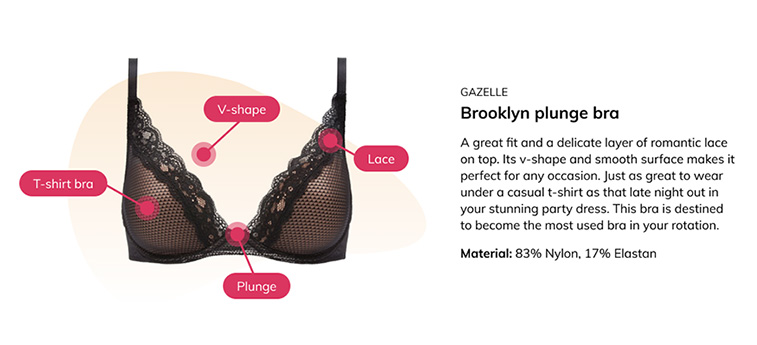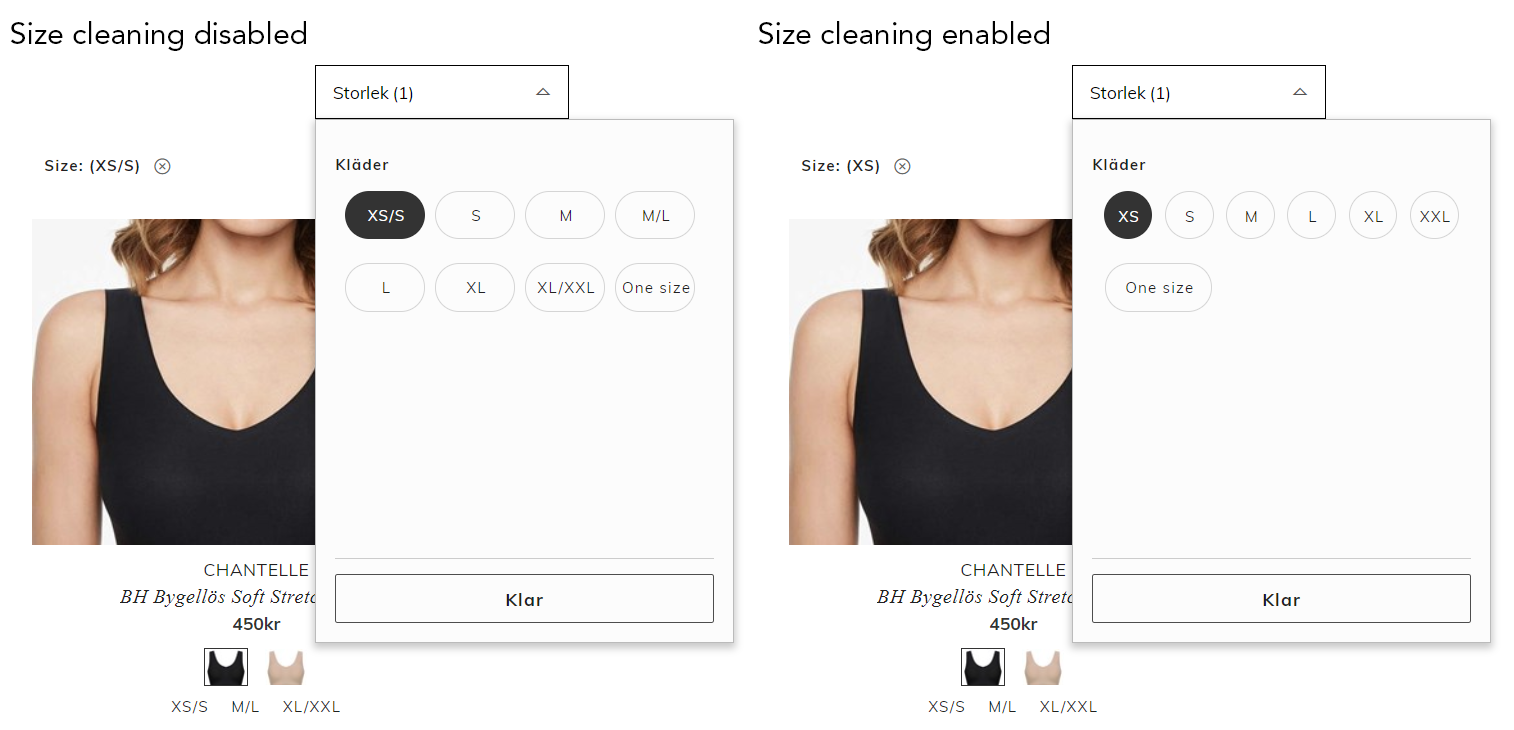Image and data analysis¶
One of the techniques Voyado Elevate applies to deliver high quality results with low effort implementations, is image and data analysis. All images available in the data feed are automatically analysed by Elevate.
Providing data in a truly structured manner is often simply not possible. In some cases, structure requires understanding of complex data relations. Neither producing nor consuming those relations are supported in all systems. Furthermore, manual tagging is hard and without exceptional discipline a lot of important information is left out. This leaves important parts of a retailers' assortment unreachable for visitors. Especially for visitors with a clear purchase intent who uses search or applies filters. This causes a poor experience for the visitor as well as a lost opportunity of sales.
Due to the importance of quality data, a lot of resources are often spent on creating product content both in terms of imagery and textual information. By automatically extracting important concepts from that data, Voyado Elevate is able to both complement and utilize these efforts as if it were structured data.
Image analysis requirements
The image analysis supports images in the following file formats: webp, png, jpg, and bmp. Image anlysis will only be performed on images with either a solid color or a gradient background.

Color analysis¶
Over 400 different colors and nuances are recognised by Voyado Elevate through image analysis, and it is all done automatically using deep neural networks.
color_override
Image analysis is primarily used for fashion. For other industries, it can be better to use the color_override attribute on Product level to get the correct color representation.
Voyado Elevate can analyse a variety of image types including cutout images and images depicting fashion models.
The analysis includes a built in understanding of color synonyms and how colors relate to each other. For example, bright red products won't be seen as burgundy. A product in a darker shade of red will however automatically be considered as burgundy and dark red, as well as red, in both search and filter contexts.
The color analysis not only determines the color nuances of a product, but also the distribution. This means that a shirt that is entirely white will be recognized as "more white" than a shirt that is striped blue and white.
Providing a color_default attribute in the data feed is beneficial for faster enabling of color search, filters, and swatches as this will take effect before the image analysis is completed. This means that colors that are available can be provided and if so, will be used until overridden by the automatic color analysis.
In cases with very complex imagery, for example boxes and packages that display other colors than the product, the color analysis can always be overridden using the color_override attribute.
Image availability¶
Proper imagery is crucial when it comes to visually driven product industries such as fashion and lifestyle. Who wishes to interact with garments without visuals?
This is in general handled well but accidents with image handling do occur, and when it does it needs to be resolved fast. To avoid the scenario of products without images filling up a site's most valuable retail space, Voyado Elevate automatically checks the image availability at regular intervals.
A product can have multiple images and a priority order of which these images are to be displayed. Should the highest prioritized image be faulty, a fallback mechanism triggers, and the second most prioritized image is displayed. Should none of the images be accessible, the product will automatically be heavily buried in all contexts. This gives a retailer minimum site impact during the time needed to work out any imagery issues.
Image resolution analysis¶
For performance reasons it is important to show images in the resolution that is appropriate for the context. Mobile devices typically use smaller images, thumbnail images are even smaller regardless of device, and for images in product listings it is important that the resolution is sufficiently high to showcase details. All images in the data feed are automatically analysed with respect to their width to provide a width value. This value can also correct an incorrect provided value.
Providing width for an image in the data feed, even if the width is not fully accurate, is beneficial for faster enabling of performance gains as these will take effect before the image analysis is completed. This means non-exact, guiding, widths can be provided that with time will be corrected if exact widths are inaccessible.
Image type analysis¶
Imagery depicting products normally come as either cutout or model images, meaning it either only displays the actual product with a plain background it is showcased on or together with a model. Proper separation of image types enables faster color analysis and improved image consistency for hover or image gallery features on product cards, as well as allows for more flexible image prioritization by merchandisers.
All images are automatically analysed with respect to their image type and an image type will automatically be provided to images without types, as well as correct any incorrectly given guiding image types.
Providing a type_default or type_override attribute in the data feed for known image types is beneficial for faster enabling of performance gains as this will take effect before the image analysis is completed. The type_default attribute can be used to provide non-exact but best guess guiding image types, where as type_override attribute is recommended if well structured data is available and the image types that are provided are known with a high degree of certainty.
Size cleaning¶
Clothing only feature
Size cleaning is currently only applied to clothing.
Sizes often come in different scales, formats, and standards. Getting sizes right and keeping these in a unified easy-to-understand manner, is especially important in industries such as fashion and lifestyle.
Getting it right manually is possible, but can be costly. It requires lots of initial working hours to get in place followed by continuous disciplined work. To alleviate retailers of this issue, Voyado Elevate comes with a size cleaning feature. It automatically extracts and tries to interpret size information from uncurated size values in mixed formats from the data feed. However, it works even better when the size formats in the data feed are somewhat standardised.

The built-in size cleaning uses several methods to curate values including:
- Expanding SML size spans, such as
S-Lto values forS,M, andLrespectively for the size facet while maintaining the correct presentation in the product card. - Combining SML size values, such as
MEDIUM,M,md,mediumto a single value. - Combining W/L (waist and length) values for trousers, such as
W32/L30,3230,32"/30". - Normalising and combining values such as
One Size,one size, andO.Sto a single value. - Combining sizes for childrens' clothing, such as
110-116and110/116. - Combining descriptions of ages for childrens' clothing. Currently only available for English, Swedish, Norwegian, Danish, and Finnish.
- Double bra sizes are split, normalised, and combined as long as the band length (if any) appears before the cup size, such as
90C/Dto90Cand90D. - Splitting of multiple sizes provided in different formats, such as
M=44/46, and size pairs separated with commas, such as44,46. - Automatic separation of formats.
When combining values, the selected representative value is determined by the most common value in the data feed.
Product type extraction¶
A lot of effort is often put into product categorization and grouping. However, many times the categorization lacks the necessary structure for it to be utilized in an optimal way.
One aspect of categorization that is especially important is the concept of product types. Product types are often lumped together with other types of concepts such as Sale, Knitted, or a combination of multiple product types such as Hats & Scarves. The data often lacks the proper granularity, i.e. the distinction between product types and collections in general. Furthermore a significant number of products are often miscategorised, despite lots of manual effort.
Through sophisticated data analysis, Voyado Elevate automatically identifies and extracts the product type.
To acquire a high precision product type identification, several methods are used. One is applying built-in relational information about product types and concepts. An example of this is applying the knowledge of T-shirt being a common fit of a bra. Rather than categorizing a T-shirt bra as both T-shirt and a bra it will correctly only be categorized as a bra with a T-shirt fit.
Another method is utilizing built-in language and terminology knowledge. For example, a Tee can be identified as a T-shirt.
Another example is the knowledge that English terms might very well appear in Swedish content, allowing weighted cross language product type identification from single attributes. The word bra meaning good in Swedish, could either be interpreted as something insignificant or as the actual product type bra. Based on context and linguistic knowledge, Voyado Elevate can assess that a bra T-shirt in Swedish likely is a T-shirt while a plunge bra likely is a bra.
Similar items¶
Finding similar items is a fundamental task for an information retrieval system like an e-commerce platform. Based on current technology, two types of item similarity are distinguished: functional and visual.
Functional similarity is achieved using concept extraction. In effect, it is assumed that functional similarity is implied by the product type. Visual similarity uses product images as input. Images are transformed into a metric space in which visually similar items are close, and dissimilar items are far away from each other.
To find similar items in the alternatives recommendation function, both techniques are merged to make sure that items are similar in both respects.